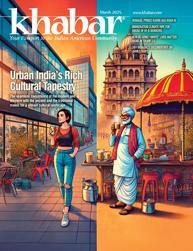The Need for South Asian Bone Marrow Donors

In most cases, this procedure is no different than donating blood. Yet, South Asian cancer patients needing bone marrow are at a disadvantage because only three percent of donors on the National Marrow Donor Program (NMDP) registry are South Asians. Since donors from a similar ethnic background are more likely to be a match, the need is urgent for South Asian donors to come forth for this life-saving procedure.
[Top] Zohra Punjani at the time of her cancer treatment.
About every three minutes, someone around the world is diagnosed with a life-threatening blood cancer such as leukemia or lymphoma. Zohra Punjani, a mother of two who lives in India, was one of them. In 2020, she was diagnosed with acute myeloid leukemia, a cancer of the blood and bone marrow that causes the patient’s body to no longer make healthy blood cells. Without successful treatment, which involves a bone marrow transplant, this condition is usually fatal. Zohra’s only chance for a cure was to hope that there was a match for her through the National Marrow Donor Program (NMDP), which also collaborates with international registries.
Donors from a similar ethnic background are more likely to be a match. There are over 22 million donors listed in the Be The Match Registry, but only about three percent of those are South Asian. This puts those with leukemia from this community at a life-threatening disadvantage when in search of a cure. Zohra was one of the rare fortunate South Asians who was able to find a match from an unrelated donor in Germany. The transplant was successful! It has been almost two years since her transplant, and she shows no signs of leukemia.
There are very many who are not as fortunate as Zohra. Unfortunately, these people eventually die from their disease when a bone marrow transplant could have likely saved their lives.
If more people with diverse ethnic backgrounds join the registry, then more lives can be saved. You can join the registry at a local in-person donor drive or at BeTheMatch.org online. Donors must be 18-40 years old. Younger donors are proven to provide better outcomes. Donors must also be willing to complete a short medical history questionnaire as well as provide a cheek swab that can be mailed for free. If matched, donating is completely free.
[Right] Zohra, who has now been cancer free for two years, is seen here with her family.
About 85 percent of the time, peripheral blood stem cells are what a donor will donate. This is like donating blood and involves no surgery. Some people who donate peripheral blood stem cells may experience body aches for a short period of time. The other 15 percent of the time, liquid bone marrow is what a donor will donate. This requires surgery under anesthesia, and some back pain and bruising are possible for a few days or weeks. No medical procedure is completely risk-free, but there are several precautions taken to ensure the safety of each donor. Complications are rare, and conversely, what is more predictable, however, is a saved life from a bone marrow transplant.
Tanya Lutfeali Lalani received her BSN from Georgia State University and a DNP-FNP degree from Augusta University (Medical College of Georgia.) She is certified as an Advanced Oncology Nurse Practitioner and is a published author.
Enjoyed reading Khabar magazine? Subscribe to Khabar and get a full digital copy of this Indian-American community magazine.
blog comments powered by Disqus











